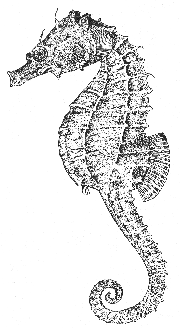Sea horse Hippocampus hudsonius DeKay 1842
[Jordan and Evermann, 1896-1900, p. 777.]

Figure 173.—Sea horse (Hippocampus hudsonius), Virgina. From Goode. Drawing by H. L. Todd.
Description—
The sea horse grotesquely resembles the "knight" in an ordinary set of wooden chessmen in its sidewise flattened body, in its deep convex belly, in its curved neck and in its curious horselike head carried at right angles to the general axis of the body. The head is surmounted by a pentagonal star-shaped "coronet," and the snout is tubular with the small oblique mouth at its tip, like that of its relative the pipefish. It has a sharp spine on each side above the eye and one behind it, a third over the gill cover, and a fourth on the side of the throat, which sometimes terminate in short fleshy filaments; also a blunt horn between the nostrils. Its neck, body, and tail are covered with rings of bony plates, 12 rings on the trunk, 32 to 35 on the tail, and each body ring is armed with four blunt spines. The body tapers suddenly behind the anal fin to a long tail, which is four-cornered in cross section, curled inward, and strongly prehensile. In the male the lower surface of the fore part of the tail bears the brood pouch, opening by a slit in front. The dorsal fin (about 19 rays) originates about midway of the length of the fish, opposite the vent, and runs backward over three and one-half rings to within half a ring of the commencement of the tail sector of the trunk. The very small anal fin stands opposite the rear part of the dorsal fin. The pectorals are of moderate size, broad based and round tipped; it has no ventral fins and no caudal fin.
Color—
Light brown or dusky to ashen gray or yellow, variously mottled and blotched with paler and darker, sometimes spangled with silver dots, sometimes plain colored. European sea horses change color according to their surroundings, tints of red, yellow, brown, and white all being within their capabilities, and it is probable that the American species is equally adaptable.
Size—
Adults usually are 3 to 6 inches long; one of 7¼ inches is the largest on record.[84]
Habits—
Sea horses dwell chiefly among eelgrass and seaweed,[85] where they cling with their prehensile tails, monkeylike, to some stalk. They usually swim in a vertical position by undulations of the dorsal fin, not with the tail, the trunk being too stiff for much sidewise motion.
Sea horses feed on minute Crustacea and on various larvae, in fact on any animal small enough, sucking in their prey as the pipefish does (p. 313.)
They breed in summer[86] and the breeding habits resemble those of the pipefish, the male nursing the eggs in his brood pouch where they are deposited a few at a time by the female in repeated pairings. The young, of which there may be as many as 150, are about 10 to 12 mm. long at hatching. When the yolk sac is absorbed the father squeezes them out of the brood sac, and they already resemble the adult in general appearance within a few days after they are set free. According to some students they swim out and in at will, but this calls for verification.
[page 316]General range—
Atlantic Coast of North America, occurring regularly from South Carolina to Cape Cod, and to Nova Scotia as a stray.
Occurrence in the Gulf of Maine—
The sea horse is not common much beyond New York. Only a few are found each year about Woods Hole, chiefly in July, August, and September, and they so rarely stray past the elbow of Cape Cod that we have found only one definite (Provincetown) and one dubious (Massachusetts Bay) record of its capture in the inner parts of the Gulf of Maine, dead or alive; and one record for Georges Bank. Three specimens of the sea horse were also reported from Nova Scotia more than ¾ of a century ago;[87] and Vladykov and McKenzie have reported one, picked up in Terrance Bay, on the outer Nova Scotian coast, Sept. 18, 1934, by V. Slaunhite.[88]
Commercial importance—
The sea horse is of no commercial value, but it is an object of constant interest to visitors to marine aquaria.
[84] Bull. New York Zool. Soc., vol. 16, 1913, p. 972.
[85] Gill (Proc. U. S. Nat. Mus, vol. 28, 1905, pp. 805-814) has given an excellent account of the habits and life history of the sea horse.
[86] Ryder (Bull. U. S. Fish Comm., vol. I, 1882, pp. 191-199) describes its development.
[87] By Knight (Catal. Fishes Nova Scotia, 1866, p. 9), as H. brevirostris Storer (1839); later by Jones, (Proc. Nova Scotian Inst. Sci., vol. 5, Part 1, 1882, p. 95) as H. antiquorum Leach 1814.
[88] Proc. Nova Scotian Inst. Sci., vol. 19, 1935, p. 5.